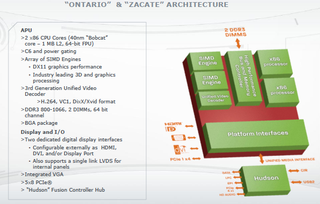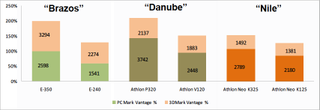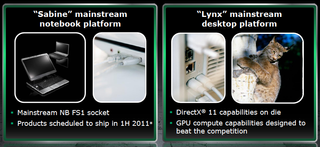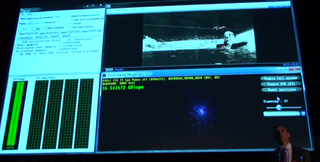AMD Fusion: Brazos Gets Previewed: Part 1
Ontario/Zacate (Bobcat-Based APUs) And Beta Drivers
It is interesting to point out that a single-core Zacate is still manufactured as a dual-core, except with one core disabled. Given the unlocking workarounds that the motherboard folks have exposed with existing dual- and triple-core Phenom IIs, we have been told it is possible to unlock that second core, provided you are married to the southbridge in the OEM's attempt to gain an additional core. Obviously there are risks, particularly as we don’t know what kind of tolerance threshold AMD is using to disable a core. Moreover, as Brazos APUs are only provided in a BGA package, the risk is bricking the entire system.
“Zacate” (18 W max)
- AMD E-350 with AMD Radeon HD 6310 Graphics (dual-core CPU @ 1.6 GHz & DX11 SIMD @ 500 MHz)
- AMD E-240 with AMD Radeon HD 6310 Graphics (single-core CPU @ 1.5 GHz & DX11 SIMD @ 500 MHz)
“Ontario” (9 W max)
- AMD C-50 with AMD Radeon HD 6250 Graphics (dual-core CPU @ 1.0 GHz & DX11 SIMD @ 280 MHz)
- AMD C-30 with AMD Radeon HD 6250 Graphics (single-core CPU @ 1.2 GHz & DX11 SIMD @ 280 MHz)
The final details of the Bobcat core have been released. Most of the technical specs are as we expected--out-of-order program and execution, something we see on most of the current x86 processors. Generally speaking, out-of-order processors increase die space because of the additional real estate space required for reordering instructions. As a result, power consumption goes up. Intel addressed this by creating Atom to be an in-order microprocessor. You can think of the difference between the two execution approaches as a to-do-list and a step-by-step flowchart. For example, when you make a sandwich, in-order execution means lettuce always comes before the tomato. Out-of-order means you just grab whatever ingredient is fastest to slap onto your slab of bread regardless of order; it ends up being faster but it generally isn't an energy efficient process.

Unlike Atom, though, AMD’s goal wasn’t to develop a “fast-enough processor” in order to achieve low power. The company’s goal was to achieve a fast processor with low power. In doing so, it favored OoO and introduced aggressive core-gating. AMD tells us it can gate off CPU cores and even portions of the APU, such as the UVD block, when not in use. This is critical to AMD’s plans to produce a processor that can deliver excess performance at a fraction of previous processor power consumption figures.

We are told that Ontario and Zacate come from the same manufacturing process, but AMD is separating them based on clock speeds. So, at the architectural level, they look identical.
There are two Bobcat cores with 1 MB L2 and a 64-bit FPU, along with a massive SIMD array, a dedicated DDR3 memory controller, unified video decoder, and a dedicated bus tying everything together. We say massive because the diagram doesn’t proportionally lay out the real estate of the individual components. Once you look at the die shot, you can see how much space the two SIMD engines take up. Boosting the computational speed for this first generation of APUs are 80 stream processors (40 per SIMD engine).
Stay on the Cutting Edge
Join the experts who read Tom's Hardware for the inside track on enthusiast PC tech news — and have for over 25 years. We'll send breaking news and in-depth reviews of CPUs, GPUs, AI, maker hardware and more straight to your inbox.
Furthermore, AMD claims to achieve 90% of K8 performance at one-third of the size. The GPU basically performs somewhere in between a Radeon HD 5400 and 5500 with the added benefit of a 6000-series card (3rd gen) UVD. According to AMD, it's directly hooking the on-die PCIe controller into the ultra-wide platform bus. There is no HyperTransport link used here.

Based on AMD’s internal numbers, we've been told to expect CPU performance similar to what we saw on this year’s Nile platforms, with a substantial increase in 3D performance (naturally).
| Battery Life (55 Wh battery) | Hours (claims) |
|---|---|
| Ontario (netbook) | 10-11 |
| Zacate (thin and light) | 8-9 |
| Single Core Atom (netbook) | 10 |
| Dual Core Atom (netbook) | 8-9 |
| Core 2 Duo (thin and light) | 6-7 |
The power management figures are a bit more interesting, falling within our expectations. Ontario doesn't seem to have as low of a minimum power state as the single-core Atoms, but keep in mind it is delivering a more compelling compute solution with close to Radeon HD 5400-class graphics. Given the ability to provide a more enriching video experience, the apples-to-apples battery life comparison may not hold up, as users feel less encumbered by a netbook platform.
Zacate is perhaps the more interesting of the two solutions (for us performance fanatics), given that it is supposed to compete against Intel's CULV (Pentium, Core 2, and Core 2 Duo) solutions often found in thin and light notebooks. Because of the limited room for add-in graphics, we often see the GMA 4500MHD on these systems. This is more than enough to watch Flash-based video (Hulu) and most high bit rate HD video, but it barely edges by in mainstream games like World of Warcraft. AMD's Zacate, meanwhile, is expected to provide comparable CPU performance with 5400-class graphics bite at a fraction of the power consumption. If AMD is can back up its claims, this is really going to be a boon for the thin and light form factor.
Code Name Cheat Sheet Updates
We spent the better part of a weekend rooting around in one of AMD’s beta Catalyst drivers provided to us by one of the company’s tech partners and calling up a few of our sources. For those that just love to get bubbly over code names...
Vancouver is AMD’s code name for the Mobility Radeon HD 6000-series. According to our sources, we only know of one specific discrete mobile GPU being readied for Q1’2011. More Mobility Radeon HD GPUs are no doubt on the horizon.
Wrestler is AMD’s code name for the GPU portion of an APU powered by a Bobcat core, so this includes the Ontario and Zacate APUs. There will be two graphic solutions: Radeon HD 6310 (Zacate) and Radeon HD 6250 (Ontario). The clock and memory speeds for the Radeon HD 6310 on the Zacate APUs are the same. This goes likewise for the 6250 on both Ontario APUs.

Sumo is AMD’s code name for the GPU portion of an Llano APU. Remember that Lynx is the mainstream desktop platform, while Sabine is the mainstream notebook platform. Both of these should come in dual, triple, and quad-core variants similar to the current Athlon II.

We've already seen a quad core Sabine. AMD actually demoed it at the TFE 2010 event and at the recent Radeon launch. Based on our sources, there should be six Llano APUs released in 2011. Three of these will be APUs for Sabine and the other three will be for Lynx. All Llanos will share the GPU core at the architectural level, most likely based on Redwood.
Remember that Sabine and Lynx are platform names, just like Brazos. A platform is defined as a CPU (APU in the case of Fusion) plus a chipset. Given what we have seen with Brazos, Sabine and Lynx are each likely to have their own southbridge or a different generational version of the same southbridge.
On a side note, in AMD's vein of using half a proper noun (Sumo Wrestler) for a code name, we have a few suggestions for future APUs. If we continuing with the whole Japanese motiff, why not "Miso" & "Soup"? Or if AMD just wants some thing along the aggressive vein, how about "Bowie" & "Knife". Jim Bowie took no prisoners and was flat out an awesome Texan to boot, so it would go well with the whole Llano tribute...
Current page: Ontario/Zacate (Bobcat-Based APUs) And Beta Drivers
Prev Page AMD Fusion: Brazos Platform Next Page Impressions And Implications-
bombat1994 awesome to see amd get into the netbook centre, finally show the public how badly the atom is clock for clockReply -
Interesting to see them projecting an increased market in netbooks given all the high profile remarks about Tablets supposedly cannibalizing it.Reply
-
acku Tablets get us into a whole other portion of the debate, as we need to start also talk about demographics. The short version of the conversation - keep in mind that a cannibalized market doesn't necessarily mean a decrease in the volume. It generally translates into a slow down in growth and a smaller proportional market.Reply
Cheers,
Andrew Ku
TomsHardware.com -
joytech22 AMD has and always will kick Intel's ass in the IGP market (excuse the rude but necessary language)Reply
Well, at least that's what i think, probably going to get downed a bit. -
compton The more the merrier. My hope is that AMD can leverage this launch into a successful campaign, then bring more competitive desktop solutions to people like me, looking at my Phenom II, then looking at the Intel 32nm core i3 that can meet or beat it... and gets worse from there. If Brazos doesn't do so hot, AMD's gonna need some serious tricks (like a miracle) to bring the heat to Intel. My Phenom II is pretty good stacked against the Core 2 but its almost 2011. Bring the funk AMD! Or let me know if you decide to... well, not. I'm ready for it now.Reply -
dEAne While AMD cannot go straight with intel in big CPU battles he makes little ones like david to bite it's toes to make intel preoccupied until bulldozer arrives.Reply -
super_tycoon Trust me, I've tried playing dirt2 on a ultra-thin and you get miso soup for graphics. A kind of foggy, blurry slurry; it's not something you really want to be associated with.Reply -
SteelCity1981 If the Graphics Core is based on the Evergreen architecture then why not just call it Radeon 5250 and 5310 series? It's just confusing to the consumor standpoint to call a Radeon GPU a 6250 and a 6310 when it's based on the Radeon 5 series. Especially considering there will be no new Radeon 6 series that will come out lower then the 6800 series.Reply -
lunyone Let's see my wishlist in a netbook or equivalent:Reply
* Decent battery life (if needed for plane trips) *possibly??
* Around 15" screen (I like this size, 10" seems too small for me) *possibly??
* Be able to play HD (whether online or off a DVD) *sounds like a good possibly??
* Be able to play most recent games on (even low settings is fine) *possibly??
*
Most Popular

